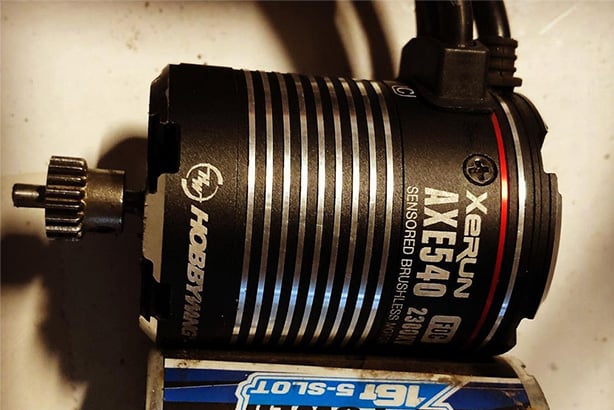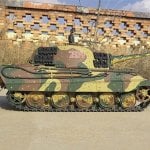The brushless motor is one of the three major power accessories of RC electric vehicles. With a suitable motor, you can get the best running effect. The following contents will help you to understand the motor easily.
RC Brushless Motor Size Chart
The size of the brushless motor is indicated by four digits, the first two digits indicate the diameter of the motor housing, and the last two digits indicate the length. For example, “3660” means 36mm in diameter and 60mm in length.

Check more parameters on Amazon
Different size motors are used in different cars. Common motor sizes on the market are as follows:
| Size | Diameter | Length | Application |
| 2030 | 20mm | 30mm | 1/16 or 1/18 scale on-road, off-road, Monster truck, etc |
| 2838 | 28mm | 38mm | |
| 3650 | 36mm | 50mm | 1/10 or 1/12 scale on-road and drift cars, 1/10 or 1/12 scale off-road vehicles |
| 3656 | 36mm | 56mm | 1/10 scale short course truck, 1/10 scale Monster truck, etc |
| 3660 | 36mm | 60mm | |
| 3674 | 36mm | 74mm | |
| 4068 | 40mm | 68mm | 1/8 scale RC cars all use these common motor sizes |
| 4074 | 40mm | 74mm | |
| 4268 | 42mm | 68mm | |
| 4274 | 42mm | 74mm | |
| 5874 | 58mm | 74mm | 1/5 scale car |
Added: 2435 motors are suitable for 1/14 – 1/18 scale cars, most have 2mm axles, but some have 3.17mm axles. 20mm or 24mm motors are usually only available without sensors.
The size of a brushed motor is represented by a three-digit number, for example:
380 (brush) ≈ 2838 (brushless)
540 (brush) ≈ 3650 (brushless)
550 (brush) ≈ 3656 (brushless)
775 (brush) ≈ 4268 (brushless)
Motor Turns vs Speed
| Turns | Watts | Speed |
| 2.5T | 730W | 11900Kv |
| 3.5T | 630W | 10800Kv |
| 4.5T | 535W | 9300Kv |
| 5.5T | 428W | 7700Kv |
| 6.5T | 404W | 6700Kv |
| 7.5T | 352W | 6100Kv |
| 8.5T | 295W | 5300Kv |
| 9.5T | 261W | 4900Kv |
| 10.5T | 243W | 4500Kv |
| 11.5-12T | ~ | 3900Kv |
| 13.5T | 201W | 3500Kv |
| 17.5T | 131W | 2500Kv |
| 21.5T | 88W | 2100Kv |
Tips: Due to the different manufacturing materials of motor suppliers, the data has slightly deviated.
Relationship between speed and voltage
30000 rpm is the best choice, the closer to this value the more efficient the motor will run. The relationship between brushless motor speed and voltage:
| Speed | 2s (7.4v) | 3s (11.1V) | 4s (14.8V) | 5s (18.5V) | 6s (22.2V) |
| 1300Kv | ~ | ~ | 19240RPM | 24050RPM | 28860RPM |
| 1400Kv | ~ | ~ | 20720RPM | 25900RPM | 31080RPM |
| 1500Kv | ~ | ~ | 22200RPM | 27750RPM | 33300RPM |
| 1600Kv | ~ | 17760RPM | 23680RPM | 29600RPM | 35520RPM |
| 1700Kv | ~ | 18870RPM | 25160RPM | 31450RPM | 37740RPM |
| 1800Kv | ~ | 19980RPM | 26640RPM | 33300RPM | 39960RPM |
| 1900Kv | ~ | 21090RPM | 28120RPM | 35150RPM | 42180RPM |
| 2000Kv | ~ | 22200RPM | 29600RPM | 37000RPM | 44400RPM |
| 2100Kv | ~ | 23310RPM | 31080RPM | 38850RPM | 46620RPM |
| 2200Kv | ~ | 24420RPM | 32560RPM | 40700RPM | 48840RPM |
| 2300Kv | ~ | 25530RPM | 34040RPM | 42550RPM | 51060RPM |
| 2400Kv | 17760RPM | 26640RPM | 35520RPM | 44400RPM | 53280RPM |
| 2500Kv | 18500RPM | 27750RPM | 37000RPM | 46250RPM | 55500RPM |
| 2600Kv | 19240RPM | 28860RPM | 38480RPM | 48100RPM | 57720RPM |
| 2700Kv | 19980RPM | 29970RPM | 39960RPM | 49950RPM | ~ |
| 2800Kv | 20720RPM | 31080RPM | 41440RPM | 51800RPM | ~ |
| 2900Kv | 21460RPM | 32190RPM | 42920RPM | 53650RPM | ~ |
| 3000Kv | 22200RPM | 33300RPM | 44400RPM | 55500RPM | ~ |
| 3100Kv | 22940RPM | 34410RPM | 45880RPM | 57350RPM | ~ |
| 3200Kv | 23680RPM | 35520RPM | 47360RPM | 59200RPM | ~ |
| 3300Kv | 24420RPM | 36630RPM | 48840RPM | ~ | ~ |
| 3400Kv | 25160RPM | 37740RPM | 50320RPM | ~ | ~ |
| 3500Kv | 25900RPM | 38850RPM | 51800RPM | ~ | ~ |
| 3600Kv | 26640RPM | 39960RPM | 53280RPM | ~ | ~ |
How to choose a brushless motor?
A properly set up high voltage system will draw fewer amps than a properly set up low voltage system that generates the same power (Watts = Volts * Amps). A system that draws fewer amps will generate less heat.
Running 3s, 4s, 5s, and 6s in 1/8th scale vehicles depends on the motor. A higher voltage system will run cooler if you use an appropriate motor KV value.
How to obtain the appropriate set-up:
- Choose the voltage you want to run.
- Pick a motor that will give you around 30000 rpm with that voltage.
- Gear it to the speed you want.
You just don‘t need the motor to spin faster than 30-40k RPM. This is a typical RPM range of a nitro engine and will be the most “driveable” configuration. If more speed is needed, you can adjust 1-3 teeth on the pinion gear without harm.
Relationship between size and speed
For the same size motor, the larger the Kv, the greater the operating power and torque.
Larger motors tend to provide more power and torque.
If you want to increase the maximum speed of the car, you can replace the motor with a larger size, or replace the motor with a larger Kv value. (Prerequisite: The vehicle has enough space and a suitable gear ratio.)
The smaller the size of the brushless motor, the higher the Kv. E.g:
- 2030 brushless motor, 6000Kv
- 4274 brushless motor, 2000Kv
Therefore, the power and torque of the motor depend on the Kv value. Size is the main factor that determines power and torque. Therefore, large-sized cars use large-sized motors with higher voltages.
Basic parameters of the motor
Turn
The number of turns indicates the number of turns the wire is wound, in T (or R). For example, if the wire is wound 21 times, the number of turns is 21T.
Low turns
Pros
- Faster speed
- More torque
- Provide more power
Cons
- Power consumption faster
- Higher fever
Rotating speed
The motor speed is usually expressed by the Kv rating. For example, 3000Kv means that increasing the voltage by 1V can increase the speed of the motor by 3000RPM. Therefore, we can calculate the speed of the motor at 8.4V (8.4v*3000kv=25200RPM)
Motor shaft diameter
The motor outputs power through the shaft, common shaft diameter:
- 2mm for 1/16 and 1/18 scale cars
- 3.175mm for 1/10 scale cars
- 5mm for 1/8 scale cars
- 8mm for 1/5 scale cars
Frequently Asked Questions
Q: What is the difference between brushed and brushless?
A: Whether brushed motor or brushless motor, their basic principle is to generate a magnetic field through a coil, and then use a permanent magnet to drive the rotor to rotate. The brushed motor uses permanent magnets as the stator and coils as the rotor. The brushless motor uses the coil as the stator and the permanent magnet as the circular rotor.
Brush motor
Pros
- Smooth operation and good startup performance
- Fast response and high starting torque
Cons
- Large loss, heat generation, short life
- Low operating efficiency and low output power
Brushless motor
Pros
- High operating efficiency
- Low loss and long life
Cons
- High cost
- Slow response and low starting torque
Q: What is the difference between sensored and sensorless?
A: The sensored motor has a position sensor, which feeds back the position of the rotor to the controller. With this position information, the controller can accurately provide the corresponding current to drive the rotor. The sensored motor has a dedicated sensor wire that connects the motor to the ESC.
Sensored motor
Pros
- Stable acceleration and better handling
Cons
- High cost
- Usually not waterproof
In contrast, a sensorless motor does not have a position sensor, it acquires the position of the rotor through random current changes at start-up, thereby controlling the current and direction.
Sensorless motor
Pros
- Lower cost
- Water proof
Cons
- Acceleration is not stable enough



